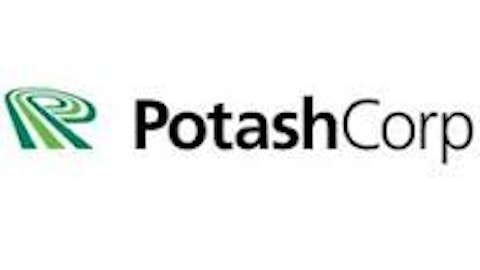When a company’s quarterly profits drop 18% year over year despite record sales for its primary product, you know you need to dig deeper into the earnings report to find out what went wrong and what it means.
I did that for CF Industries Holdings, Inc. (NYSE:CF), and I found out that it was the higher cost of the key input, natural gas, that hurt CF’s profits. As an investor, you may find that reason enough to raise a yellow flag, but hold on: CF’s second-quarter earnings report revealed important factors that might even compel you to add the stock to your portfolio.

CF’s nitrogen complex at Donaldsville is also North America’s largest. Image source: theadvocate.com
When a drop looks good
While a shrinking top line can never be a good thing, CF Industries Holdings, Inc. (NYSE:CF) still deserves the accolades for delivering the smallest drop in revenue among the leading fertilizer companies during the last quarter. CF’s second-quarter revenue was just about a percent lower, year over year. Comparatively, Potash Corp./Saskatchewan (USA) (NYSE:POT) and Mosaic Co (NYSE:MOS) reported 11% and 5% drops, respectively, in their last-quarter revenues. Agrium Inc. (USA) (NYSE:AGU) was the only company to deliver 4% growth on the top line in its last quarter, but all those gains came from its seeds and crop protection products business. Agrium Inc. (USA) (NYSE:AGU)’s wholesale division, which constitutes fertilizers, reported a 9% fall in revenue.
These numbers prove CF Industries Holdings, Inc. (NYSE:CF)’s resilience in an otherwise volatile business, and its stand-out performance can be entirely attributed to its nutrient mix — CF derived 89% of its revenue from nitrogen products in Q2. Phosphate made up the remaining portion.
None of the other companies mentioned above rely as heavily on nitrogen as CF does. While Potash Corp./Saskatchewan (USA) (NYSE:POT) and Mosaic specialize in potash and phosphate nutrients, Agrium Inc. (NYSE:AGU) isn’t strictly a fertilizer company.
It’s an advantageous business model
So what makes nitrogen so advantageous for CF Industries Holdings, Inc. (NYSE:CF)? The most obvious reason is that nitrogen is the most essential nutrient for corn, which results in a relatively inelastic demand for the nutrient. Moreover, as compared to potash or phosphate, nitrogen is absorbed faster by the soil, making it necessary to reapply the nutrient every time a new crop is planted. These two factors ensure that CF’s nitrogenous products have enough takers at almost all times.
Consistent demand has also resulted in firm prices of nitrogen products over the years, unlike those of potash and phosphate. What’s more, potash prices are staring down the barrel after the recent shake-up in the fertilizer industry, which works in CF’s favor; unless, of course, farmers suddenly take to potash over nitrogen in the wake of lower potash prices. But that’s unlikely, given the critical dependence of corn crop on nitrogen.
It looks like CF Industries Holdings, Inc. (NYSE:CF) can’t go wrong with its specialization in nitrogen products, as evidenced by its solid second-quarter performance when revenue from its nitrogen division hit a record high of $1.5 billion. Investors should be happy.
Flexibility that counts
CF’s second quarter was yet another proof of how efficiently the company monitors and changes its product mix to suit the present market conditions. CF deals in several nitrogen products, such as urea, ammonia, and urea ammonium nitrate, or UAN.
During the last quarter, CF Industries Holdings, Inc. (NYSE:CF)’s urea selling prices fell sharply by 26% year over year as farmers deferred application on cooler weather conditions even as cheaper urea products from China flooded the market. Given that urea constituted nearly 20% of CF’s total sales volumes during the quarter, the company’s top line could have taken a hard hit. Thankfully, that wasn’t to be.



